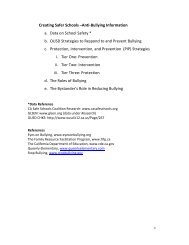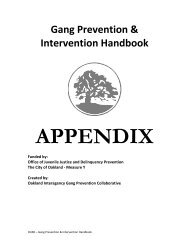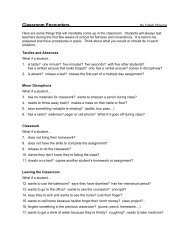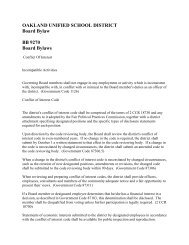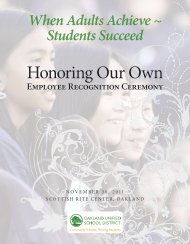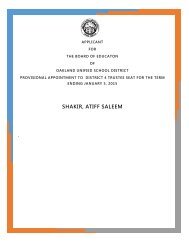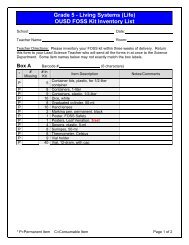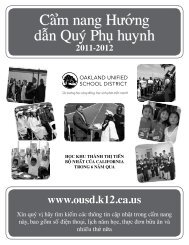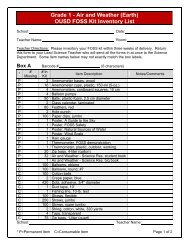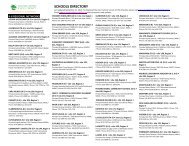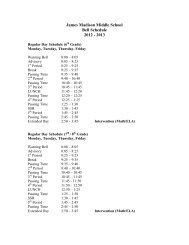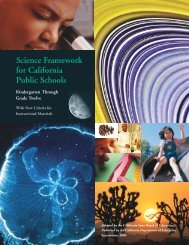Oakland Unified School District Case Study
Oakland Unified School District Case Study
Oakland Unified School District Case Study
You also want an ePaper? Increase the reach of your titles
YUMPU automatically turns print PDFs into web optimized ePapers that Google loves.
terms of the work and the shift from<br />
teacher-centered to student-centered,<br />
it is really about social justice, because<br />
if kids are reliant on the teacher<br />
for the answers, then that has<br />
major political ramifications for who<br />
they become as adults. If children<br />
can pick up a book on their own and<br />
make meaning and ask questions<br />
and apply what they learn in really<br />
effective ways, that has a more positive<br />
impact on who they become as<br />
adults — they’re the agents in their<br />
own learning, and that’s huge, when<br />
it comes to social justice.<br />
Students also gain other educational opportunities<br />
through the Extended Learning<br />
Program (ELP). The ELP, which runs from<br />
the end of the school day until 6:00 p.m.,<br />
serves 170 of the 260 students on campus,<br />
with 120 of these students attending until<br />
6:00 p.m. Although the school contracts<br />
with the <strong>Oakland</strong> Youth Chorus as its lead<br />
agency for the program, the program is cocreated<br />
with the AWE staff and effectively<br />
becomes on extension of AWE rather than<br />
an unrelated add-on at the end of the day.<br />
While the program provides valuable opportunities<br />
for students, many parents and<br />
school leaders also acknowledge it plays a<br />
valuable role in keeping the students safe.<br />
As one school leader said, “Who knows<br />
what these kids would be doing during this<br />
time.” The program is a combination of<br />
required academics, choice academics, and<br />
recreation. On one afternoon, we observed<br />
that after a brief snack time, students<br />
rotated through sessions in one-hour increments<br />
that ranged from art, drumming,<br />
dance, and chorus to required and choice<br />
academics. All students in grades 2-5 have<br />
individualized, required, extended learning<br />
academic schedules that included small<br />
group tutorials or additional classes. One<br />
student indicated that she was in the ELP<br />
for support in science because she had<br />
fallen behind when a long-term substitute<br />
teacher taught her science class. While all of<br />
these programs effectively complement the<br />
instructional program at AWE, the leadership<br />
class illustrates the AWE instructional<br />
philosophy particularly well.<br />
The leadership class is a one of the “choice<br />
academic” classes. It is a combination of<br />
fourth- and fifth-grade students who are<br />
taught leadership skills and are given specific<br />
responsibilities in running the school,<br />
such as planning and facilitating assemblies,<br />
and managing the school recycling program.<br />
In the leadership class, students are<br />
held to high expectations and develop skill<br />
sets, such as public speaking and creating<br />
agendas, with an eye toward future leadership<br />
positions. The class makes the vision<br />
into a reality by training young scholars<br />
to transform the world around them while<br />
they are still in elementary school.<br />
AWE has developed a data-driven instructional<br />
program that couples high expectations<br />
with providing the supports necessary<br />
to work with students at all levels of<br />
knowledge and skill. The program is rooted<br />
in knowing the students well and investigating<br />
effective curriculum and teaching<br />
methods to produce high student learning<br />
results. By focusing on a creating an<br />
instructional program based on multiple<br />
forms of student data (e.g., CST scores,<br />
interim assessments, teacher observations),<br />
AWE has leveraged its small size to improve<br />
academic outcomes. As Kean says, “Small<br />
schools can be transformative because we<br />
can personalize our support and provide<br />
more academic opportunities for the kids<br />
who need it. We can be transformative because<br />
we are small. If we had 500 kids, we<br />
couldn’t do the things we do.”<br />
14<br />
<strong>School</strong> Redesign Network at Stanford University



